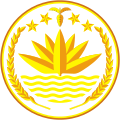| Local government in Bangladesh | |
|---|---|
 | |
| Category | Unitary state |
| Location | Bangladesh |
| Number |
|
| Populations | 3,212 (Union Councils) – 36,054,418 (Divisions)[citation needed] |
| Areas | 9 km2 (Union Councils) – 7,468 km2 (Divisions)[citation needed] |
| Government |
|
| Subdivisions | |
| This article is part of a series on the |
| Politics of Bangladesh |
|---|
 |
|
|
|
|
There are 8 divisions and 64 districts in Bangladesh, each district further subdivided into upazila (lit. subdistricts). The area within each subdistrict, except for those in metropolitan areas, is divided into several unions, with each union consisting of multiple villages. Direct elections are held for each union (or ward), electing a chairperson and a number of members. In 1997, a parliamentary act was passed to reserve three seats (out of 12) in every union for female candidates.[1] Following elections in the 2014–16 period, 25.2% (14,763/ 58,543) of councillors were women, up from 23.4% in the 2011–13 period.[2]
In Bangladesh, the rural and regional local government have four tiers:
- Divisional administration
- District administration
- Sub-district administration
- Rural, Municipal and City councils


